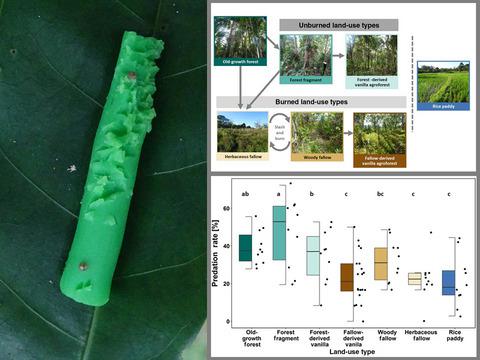当前位置:
X-MOL 学术
›
J. Appl. Ecol.
›
论文详情
Our official English website, www.x-mol.net, welcomes your
feedback! (Note: you will need to create a separate account there.)
Decreasing predation rates and shifting predator compositions along a land‐use gradient in Madagascar's vanilla landscapes
Journal of Applied Ecology ( IF 5.0 ) Pub Date : 2020-10-20 , DOI: 10.1111/1365-2664.13766 Dominik Schwab 1 , Annemarie Wurz 1 , Ingo Grass 2 , Anjaharinony A. N. A. Rakotomalala 3 , Kristina Osen 4 , Marie Rolande Soazafy 5, 6 , Dominic A. Martin 7 , Teja Tscharntke 1
中文翻译:

降低马达加斯加香草景观中的捕食率并使捕食者组成沿土地利用梯度转移
更新日期:2020-10-20
Journal of Applied Ecology ( IF 5.0 ) Pub Date : 2020-10-20 , DOI: 10.1111/1365-2664.13766 Dominik Schwab 1 , Annemarie Wurz 1 , Ingo Grass 2 , Anjaharinony A. N. A. Rakotomalala 3 , Kristina Osen 4 , Marie Rolande Soazafy 5, 6 , Dominic A. Martin 7 , Teja Tscharntke 1
Affiliation

|
- Land‐use change is the main driver of deforestation and land degradation resulting in the loss of biodiversity and ecosystem functioning in north‐eastern Madagascar. Vanilla, the region's main cash crop, is grown in agroforestry systems and may provide an opportunity for the conservation of biodiversity and ecosystem functioning.
- We used dummy caterpillars to assess predation rates and predator communities along a land‐use gradient including unburned old‐growth and forest fragments, herbaceous and woody fallows after shifting cultivation with fire usage, as well as rice paddies. The studied vanilla agroforests were either forest‐derived or fallow‐derived. Besides land‐use type, we considered the effects of land‐use history (unburned/burned), plot‐level parameters and the landscape composition to conclude on management recommendations.
- Old‐growth forest and forest fragments exhibited highest predation rates, which decreased with land‐use intensity. Overall, predation was higher in unburned land‐use types than in more open, previously burned habitats and rice paddies. High stem and vegetation densities were positively related to predation rates, but decreased with land‐use intensity. High forest cover in the surrounding landscape led to higher predation rates, while local structural parameters remained more important.
- The predator community was arthropod‐dominated across all land‐use types with ants responsible for between 33% and 69% of all predation events. Overall predator composition in old‐growth and forest fragments differed from all other land‐use types. Predation by Gryllacrididae (Orthoptera) was lower in all land‐use types, including forest‐derived vanilla, than in old‐growth forest and forest fragments, where they were important contributors to total predation. Vertebrate predation was low throughout.
- Synthesis and applications. Forested habitats feature higher predation rates and different predator compositions than other land‐use systems. Maintaining or restoring tree‐ and understorey‐rich vanilla agroforestry represents a viable tool in landscape conservation programmes as it has the potential to contribute to the conservation of predation as an important ecosystem function in both forest‐ and fallow‐derived agroforests. However, vanilla agroforestry has limited value in conserving forest‐specialized predator communities. While the establishment of tree‐rich agroforests on former fallow land is favourable for conservation ecosystem functioning, further forest transformation should be avoided.
中文翻译:

降低马达加斯加香草景观中的捕食率并使捕食者组成沿土地利用梯度转移
- 土地用途的变化是毁林和土地退化的主要驱动力,导致马达加斯加东北部的生物多样性丧失和生态系统功能丧失。香草是该地区的主要经济作物,种植在农林业系统中,可能为保护生物多样性和生态系统功能提供机会。
- 我们使用假毛虫来评估土地利用梯度上的捕食率和捕食者群落,包括未燃烧的老树和森林碎片,因火种转移耕种后的草木和木休耕地以及稻田。所研究的香草农用林是源自森林或来自休耕地。除了土地利用类型,我们还考虑了土地利用历史(未燃烧/已燃烧),地块级参数和景观组成的影响,以得出管理建议。
- 老龄森林和森林碎片的捕食率最高,随土地利用强度的增加而降低。总体而言,未燃烧的土地利用类型的捕食活动要比更开放的先前燃烧的栖息地和稻田的捕食活动高。高的茎和植被密度与捕食率呈正相关,但随着土地利用强度的降低而降低。周围景观的高森林覆盖率导致较高的捕食率,而当地的结构参数仍然更为重要。
- 在所有土地利用类型中,节肢动物都以节肢动物为主,其中蚂蚁占所有捕食事件的33%至69%。老龄和森林碎片中的总捕食者组成与所有其他土地利用类型不同。Gryllacrididae(直翅目)的捕食在包括森林衍生的香草在内的所有土地利用类型中均比旧的森林和森林碎片要低,在后者中它们是总捕食的重要因素。脊椎动物的捕食度一直较低。
- 综合与应用。与其他土地利用系统相比,森林生境具有更高的捕食率和不同的食肉动物组成。维护或恢复富含树木和林下层的香草农用林业是景观保护计划中的可行工具,因为它有可能有助于保护作为森林和休闲农用林中重要的生态系统功能的捕食活动。但是,香草农林业在保护森林专业捕食者社区方面的价值有限。虽然在原休耕地上建立树木丰富的农林有利于保护生态系统的功能,但应避免进一步的森林转型。











































 京公网安备 11010802027423号
京公网安备 11010802027423号